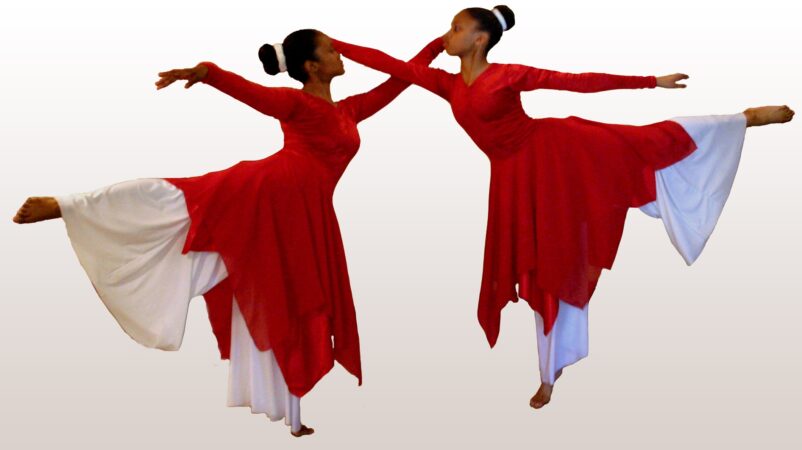From ancient times to the present, dancers have expressed ideas, stories, and rhythm with their bodies. They use a variety of dance forms that allow free movement and self-expression, including classical ballet, modern dance, and culturally specific dance styles. The Biblical significance of dance is better understood by thoroughly examining the diversity and frequency with which scripture uses terms for dance.
Hastings Dictionary of the Bible defines dance as “an expression of the feelings by movements of the body, more or less controlled by a sense of rhythm.”
The bible says that in him we move, breathe and have our being. God made the human body with both eyes and ears, and the “Body of Christ” also needs to see and hear, to be seen and heard. When we can visualize the nature and character of God we can better understand and better worship Him. Dance adds the visual aspect to worship.
Dancing seems to have occurred at certain very great occasions in Israel’s history.
Ex 15:20—Miriam leads the dance after the Red Sea crossing, Israel birthed
as a nation.
2 Sam 6:14—Dance ushered in the establishment of the Davidic Kingdom and a new order of worship. Jer 31:4,13—Dance and the return from captivity in Babylon.
Dance is the fulfillment of prophecy.
“Again I will build you, and you shall be rebuilt, O virgin of Israel! You shall again be adorned with your tambourines, and shall go forth in the dances of those who rejoice” Jer 31:4 (“virgin of Israel” = the Bride, the end time church).
Dance is a sign of blessing and restoration in the church.
2 Sam 6:13-14—dance is associated with the restoration of the glory of God to his people. The joy of our heart has ceased; our dance has turned into mourning” Lam 5:15—the absence of dance is a sign of judgment.
Dance resists the enemy (Jam 4:7).
3 main occasions for dance in Israel’s day—harvest, marriage, victories in battle—all 3 of which spiritually point to the end times. When we dance it is a sign to Satan that his time is short! The authority of the feet—Gen 3:5, Rom 16:20, Ps 8:6, etc.—Satan is particularly nervous about what your feet are doing!
The range of expressive movement which the Bible describes includes leaping, jumping, running, to hop, skip, whirl, turn, twist, spiral, spin, to writhe or contract, to gallop, prance, stamp feet, to tremble, to circle around, to laugh and rejoice, to stretch, be limber, to throw up the hands, to clap, bow down, fall down prostrate, arise and stand up.
A. Mahol—“to dance with joy” over the blessings of God both present and future.
1) Ps 149, 150—because of His mighty acts and greatness.
2) Jer 31:31—because of future blessings.
3) N.T. parallel “choros” Luke 15:25 (dancing at banquet of prodigal son).
B. Mehola—“a joyous dance of celebration” usually for military victories or festivals.
May include round dances, interpretive or imitative dance (pantomimic dance), or responsive movement to a dance leader (“choregos” in Greek).
1) Song 6:13—“the dance of Mahanaim” or 2 armies (military).
2) Ex 15:20—victory over Pharoah’s armies (responsive).
3) 1 Sam 18:6-7—David & Saul’s victory (military).
4) N.T. parallel “orcheomai”—to dance in a row or rings as in ranks (Mark 6:22)
C. Hul—root word with 2 primary meanings: “writhing in travail or trembling,” and “whirling in a spiral motion.” Used in a broader sense, more figuratively applies to emotions or attitudes associated with the movements.
1) Ps 97:4—the earth saw and “trembled;” Is 23:5—“agony” at God’s judgment.
2) Jer 23:19—God’s anger in a “whirlwind;” Hos 11:6—whirling of a sword.
D. Giyl—“to circle in joy”—rejoicing at God’s works or attributes.
1) Ps 45:15—joy of a wedding procession.
2) 2. Is 9:3—joy of a redeemed nation.
3) Zech 9:9—joy of the coming Messiah
4) 4. Ps 118:24—rejoice in a new day.
5) N.T. parallel “agalliao”—to exult & jump for joy (1 Pet 1:6-8, 4:13, Rev 19:7, Luke1:14, Luke 10:21)
E. Pazaz—“to be supple or agile in movement, to spring up.”
1) 2 Sam 6:16—David leaping before the ark.
2) N.T. parallel “hallomai”—Acts 3:8 healed lame man leaped up.
F. Dalag—“to leap” as hurtling over an object.
1) Song 2:8—leaping on the mountains.
2) 2. 2 Sam 22:30—leaping over a wall.
G. Ragad—“to stamp feet and skip about” as in playful movements of children.
1) Job 21:11—children dancing
2) 2. Ps 29:6—Lebanon to “skip” like a calf.
H. Yadah—“to throw up the hands” in confession of praise, to acknowledge God’s character, or to acknowledge sin (surrender)
1) Ps 86:12—“praise” Him with all your heart.
2) Ps 105:1—“give thanks” “make known His deeds among the peoples!”
3) Ps 32:5—“acknowledge” sin and “confess” transgressions to the Lord.
I. Shaha—“to fall down in worship, to bend or stoop”
1) Is 45:14—“they shall fall down to thee.”
2) 2. Is 49:23—“they shall bow down.”
J. Kara—“to bend the knee, to prostrate oneself.”
1) Ps 95:6—“come let us worship and bow down.”
2) Is 45:23—“every knee shall bow.”
3) N.T. parallel “kampto”—to bend or bow low (Phil 2:10)
K. Quwm—“to rise up and stand”
1) Song 2:13—arise my love.
2) 2. Is 60:1—“arise, shine; for your light has come!”
The range of expressive movement which the Bible describes includes leaping, jumping, running, to hop, skip, whirl, turn, twist, spiral, spin, to writhe or contract, to gallop, prance, stamp feet, to tremble, to circle around, to laugh and rejoice, to stretch, be limber, to throw up the hands, to clap, bow down, fall down prostrate, arise and stand up.
Dancers normally work with choreographers, who create original dances and develop new interpretations of existing dances. Because few dance routines are written down, choreographers instruct performers at rehearsals to achieve the desired effect. In addition, choreographers usually are involved in auditioning performers.
